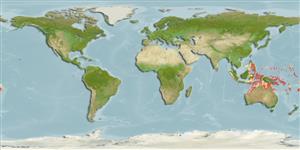Classification / Names
Common names from other countries
Main reference
Size / Weight / Age
Max length : 8.0 cm TL male/unsexed; (Ref. 2334)
Environment
Marine; reef-associated; depth range 18 - 50 m (Ref. 48635)
Climate / Range
Tropical, preferred ?; 15°N - 20°S
Distribution
Western Pacific: Philippines, Palau, Papua New Guinea, the Solomons, Fiji, and Osprey Reef in the Coral Sea; also in Rowley Shoals in the eastern Indian Ocean.
Countries | FAO areas | Ecosystems | Occurrences | Introductions
Short description
Dorsal
spines
(total): 8;
Dorsal
soft rays
(total): 11-12;
Anal
spines: 3;
Anal
soft rays: 8. Easily identified by the unusual coloration. The yellow is obvious but the red looks grey when seen in natural light (Ref. 48635). Differs from L. tonstrinum by having numerous red pinstripes on its sides, a less pronounced white lateral stripe, and a serrate posterior preopercular margin (Ref. 37816).
IUCN Red List Status (Ref. 115185)
Threat to humans
Harmless
Human uses
More information
Common namesSynonymsMetabolismPredatorsEcotoxicologyReproductionMaturitySpawningFecundityEggsEgg development
ReferencesAquacultureAquaculture profileStrainsGeneticsAllele frequenciesHeritabilityDiseasesProcessingMass conversion
Tools
Special reports
Download XML
Internet sources
Estimates of some properties based on models
Phylogenetic diversity index
PD50 = 0.5000 many relatives (e.g. carps) 0.5 - 2.0 few relatives (e.g. lungfishes)
Trophic Level
3.4 ±0.6 se; Based on size and trophs of closest relatives
Resilience
High, minimum population doubling time less than 15 months (Preliminary K or Fecundity.)
Vulnerability
Low vulnerability (12 of 100)
Price category
